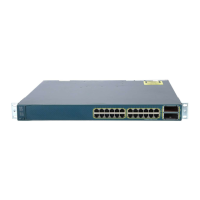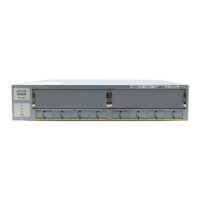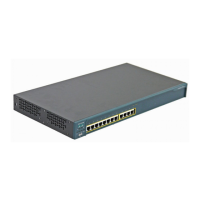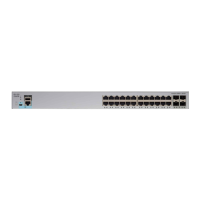31-31
Catalyst 3750 Switch Software Configuration Guide
78-16180-02
Chapter 31 Configuring Network Security with ACLs
Configuring VLAN Maps
• If the VLAN map has at least one match clause for the type of packet (IP or MAC) and the packet
does not match any of these match clauses, the default is to drop the packet. If there is no match
clause for that type of packet in the VLAN map, the default is to forward the packet.
• The system might take longer to boot if you have configured a very large number of ACLs.
• Logging is not supported for VLAN maps.
• If VLAN map configuration cannot be applied in hardware, all packets in that VLAN must be
bridged and routed by software.
• When a switch has an IP access list or MAC access list applied to a Layer 2 interface, and you apply
a VLAN map to a VLAN that the port belongs to, the port ACL takes precedence over the VLAN
map.
• You can configure VLAN maps on primary and secondary VLANs. However, we recommend that
you configure the same VLAN maps on private-VLAN primary and secondary VLANs.
• When a frame is Layer-2 forwarded within a private VLAN, the same VLAN map is applied at the
ingress side and at the egress side. When a frame is routed from inside a private VLAN to an external
port, the private-VLAN map is applied at the ingress side.
–
For frames going upstream from a host port to a promiscuous port, the VLAN map configured
on the secondary VLAN is applied.
–
For frames going downstream from a promiscuous port to a host port, the VLAN map
configured on the primary VLAN is applied.
To filter out specific IP traffic for a private VLAN, you should apply the VLAN map to both the
primary and secondary VLANs. For more information about private VLANs, see Chapter 15,
“Configuring Private VLANs.”
• See the “Using VLAN Maps in Your Network” section on page 31-34 for configuration examples.
• For information about using both router ACLs and VLAN maps, see the “Guidelines” section on
page 31-37.
Creating a VLAN Map
Each VLAN map consists of an ordered series of entries. Beginning in privileged EXEC mode, follow
these steps to create, add to, or delete a VLAN map entry:
Command Purpose
Step 1
configure terminal Enter global configuration mode.
Step 2
vlan access-map name [number] Create a VLAN map, and give it a name and (optionally) a number. The
number is the sequence number of the entry within the map.
When you create VLAN maps with the same name, numbers are assigned
sequentially in increments of 10. When modifying or deleting maps, you
can enter the number of the map entry that you want to modify or delete.
Entering this command changes to access-map configuration mode.
Step 3
action {drop | forward} (Optional) Set the action for the map entry. The default is to forward.
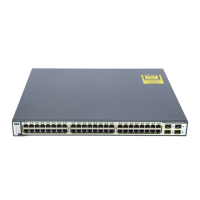
